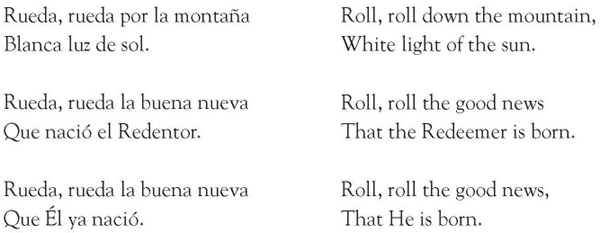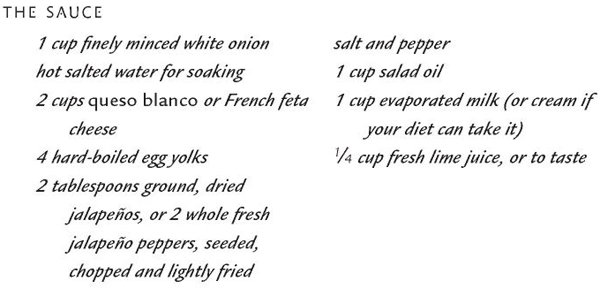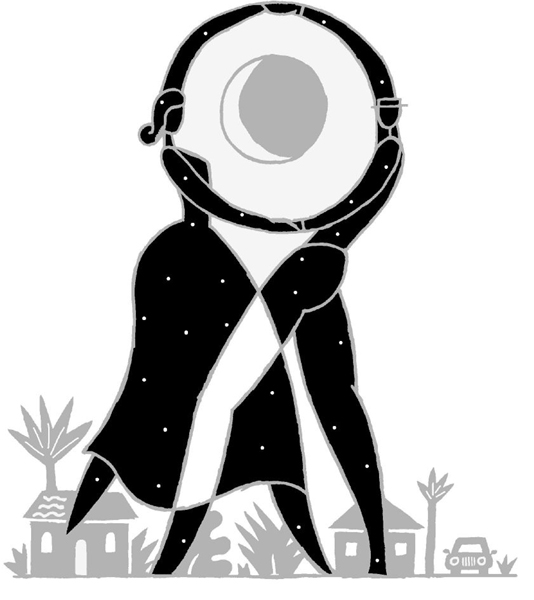Las Christmas (4 page)
Mandalit
del
Barco
Mandalit del Barco was born in Lima, Peru and grew up in Baldwin, Kansas.
She is a frequently heard staff reporter for National Public Radio. She is also
a contributor to the NPR program
Latino USA.
A former staff writer for the
Miami Herald,
she is a past contributor to
The Village Voice.
PEMEX XMAS

SINCE WE WERE the only Peruvian-Mexican family in the one-horse town of Baldwin, Kansas, we invented our own multicultural rituals to celebrate Christmas del Barco.
It was the 1960s, and we had immigrated from South America to the Sunflower State, where Mom had grown up. While in Peru studying folklore on a Fulbright scholarship, Mom met Dad, a dashing journalist and actorâand their international love story began. I came into the picture in cosmopolitan Lima, and eighteen months later we moved to Kansas, just before my brother, Andy, was born.
In the years that followed, Mom taught Spanish literature at a small college while Dad worked on a graduate thesis in anthropology. We were probably the only family in Baldwin who collectively protested the war in Vietnam and boycotted nonunion grapes. While our neighbors remained nestled comfortably in some earlier, small-town eraâa throwback to the fifties, forties or even the thirtiesâwe campaigned against Nixon, championed women's lib, and joined in Native American powwows. The place always reminded me of
Mayberry, R.F.D.,
though Andy jokes that if Baldwin was Mayberry, then we were something like the Addams Family. Let's just say I had the feeling we were
not
in Lima anymore.
In this snowbound prairie town, our hybrid holiday would always begin with the perennial viewing of our TV favorite,
How the Grinch Stole Christmas.
Instead of “roast beast,” our meal generally consisted of Peruvian
papas a
la huancaÃna
and a delicious
marisco-
filled
chupe de camarones
made by Dad, who pointed out that in Quechuaâthe Indian language of his native Peru
â
chupe
means soup. Sometimes he'd make ceviche, or Mom would prepare tamales and enchiladas. For dessert, we savored the
buñuelos y chocolate,
which Mom made in her traditional Mexican style, spicing the condensed milk and Hershey's with sticks of cinnamon.
On Christmas Eve, Andy and I would inevitably fall asleep waiting for our pet cats to talk to us, as we were told all the animals would at midnight. Was that a Mexican tradition? Peruvian? American? Our ideas about Christmas were
una mezcla,
a mix. Among the figurines in our
nacimiento,
the Nativity scene handmade in Ayacucho out of
piedra de Huamanga
(an alabaster from the Andean highlands), Andy and I would position our Sesame Street finger puppets. This way, Big Bird, Grover, Ernie, and Bertâwhom we dressed in red felt costumesâassumed their rightful places next to Baby Jesus and a fuzzy llama, scaled to size.
Mom and Dad would address our gifts with joke tags like “For Andy: from the third elf on the left,” or “For Mandalit: from the combined elf chorus.” In return, Andy and I would put on yet another ad-libbed puppet show, from behind the cleverly designed puppet theater Dad built for us. Or we'd make up another satirical radio play, recorded reel-to-reel, using
Mad
magazineâ style puns, like this feminist Christmas comedy in which Ms. Sandy Claus takes over the job of delivering toys one year when Santa is sick. She's been caught breaking and entering and is now standing trial.
ANDY (as thief Rob Burr, with a Brooklyn accent): I was goin' ta work on my regular block, and I sees dis here dude widdah red suit. I figured he wuz tryin' ta muscle in on my act. Then as he was goin' tru the window, his beard got caught on a tree limb and came off. I sees dat it was a lady, of all tings. I figuredat she was what you might call one of dem male impersonators.
MANDALIT (as militant defendant Sandy Claus): How dare you insult my identity!
ANDY (this time as stuffy Judge Soy Bean): Order!
MANDALIT (now a sarcastic trial watcher): I'll take a pastrami on rye . . .
Besides creating satires, my family introduced the neighborhood to some Latino traditions. Folks in Baldwin didn't know from
las posadasâ
caroling in Spanishâand there was no
misa del galloâ
midnight mass. But we'd invite the Brady Bunchâlike neighborhood kids to help us light candles in the sidewalk
luminarias
we made from paper lunch bags weighted with sand (a New Mexico tradition from Mom's side). And they helped us knock down our homemade piñatas. Somehow, we even taught them a few Mexican and Peruvian folk songs, though they probably had no idea what the words meant. But that didn't matter much.
There was always a foreign student or five visiting our house for Christmasâfrom Peru or Kenya or China or Costa Rica. Imported from Somalia, Mexico, and Colombia, too. One year, the entire college soccer team showed up to share in our polyglot celebrations. We were all expatriates, living in the land of Ahs, making things up as we went along.
Feliz Navidad.
Or as they say in Kansas, Merry Christmas.

RUEDA, RUEDA
A Villancico from Peru

Papas
a la
HuancaÃna
PERUVIAN POTATO SALAD

There are two versions of this recipe. This one uses
salsa cruda,
an uncooked sauce. Some families prefer a
salsa cocida,
a sauce cooked on the stove, and add crushed Saltines, peanuts, and other ingredients. This is a home recipe contributed by Mandalit's parents, Dolores and Renán del Barco, so feel free to add or subtract garnishes as you like.
THE POTATOES
10 yellow potatoes
Boil the potatoes in salted water just until they can be pierced easily with a fork. Don't overcook! They shouldn't be mushy. Cool and peel.
THE SAUCE

Soak the sliced white onion in hot salted water.
Mash the cheese and egg yolks together in an electric mixer or blender. Add jalapeño peppers, salt, and pepper. Mix well. Add oil, pouring gradually, while continuing to mix on high speed. Add milk and lime juice, blending well. Drain the white onion well, and fold into the mixture with a spoon.

Rinse the sliced red onion in hot water, then cover with lime juice and chiles.
Slice the peeled potatoes. Arrange butter lettuce leaves around the edge of a serving platter. Pile sliced potatoes in the center and cover with the sauce. Decorate with corn, olives, sliced boiled eggs, and the drained red onion rings.
Makes
8
servings
Gustavo Pérez Firmat
Gustavo Pérez Firmat was born in Havana, Cuba, and raised in Miami, Florida.
A recipient of fellowships from the National Endowment for the Humanities, the
American Council of Learned Societies, and the Guggenheim Foundation, he is
currently Professor of Spanish at Duke University. His numerous volumes of
literary and cultural criticism include
Literature and Liminality
and
Do the Americas Have a Common Literature?
(both Duke University Press) and
Life on the Hyphen: The Cuban-American Way
(University of Texas Press),
which was awarded the Eugene M. Kayden University Press National Book Award.
His collections of poetry in Spanish and English include
Carolina Cuban, Equivocaciones,
and
Bilingual Blues.
This story is adapted from a chapter
of his memoir,
Next Year in Cuba: A Cubano's Coming of Age in America
(Anchor Books).
GOOD NIGHT TO NOCHEBUENA

WHEN I WAS GROWING up in Cuba, Nochebuenaâliterally, “the good night”âwas the holiest and happiest night of the year. Divided in half by midnight mass, the Cuban Christmas Eve oscillated, sharply but predictably, between the sacred and the profane, between religious ritual and secular mirth-making. Since, in the fifties, Catholics were still required to fast before receiving Holy Communion, the celebration that accompanied the religious observance was not supposed to begin until one or two o'clock in the morning, after everyone got back from
la misa del gallo,
whose name goes back to the Roman custom of holding mass at dawn, when the
gallos,
or cocks, crowed. But cultural differences being what they are, Cuban roosters began crowing long before the Roman cocks. Well before midnight my uncles, who typically were less devout than their wives, were already well into their Bacardi cups. When they accompanied their wives and children to midnight mass, they remained on the steps of the church while the rest of us went inside to pray. It was a curious sight: from inside the church I could see the crowd of men, impeccably dressed in their long-sleeved guayaberas with bow ties, milling around and talking. The hubbub was such that Father Spirali, the Italian-born pastor of the San AgustÃn parish in Havana, sometimes had to interrupt the mass to hush the men congregated outside. I couldn't wait to be old enough to join them.

Nochebuena was essentially a feast for grown-ups. Because most Cuban children received their holiday gifts on January 6, the Feast of the Epiphany, nothing that happened on Christmas Eve had to do directly with us. At our house my brothers, my baby sister, and I had to go to sleep before
la misa del
gallo.
The last couple of years in Cuba, my brother Pepe and I were allowed to attend midnight mass, but since our American-tinged household was visited both by Santa Claus and the Three Wise Men (Santa brought the better gifts), we were still packed off to bed sooner rather than later with the pretext that Santa wouldn't come until all of the children were asleep. But it was hard to get to sleep on Nochebuena, a good but not a silent night.
At least for me, the best part of Christmas wasn't Nochebuena but the preparations that preceded it. Like other Cuban couples, my parents had an uneven division of festive labor: my mother prepared, and my father partied. Her job was to set everything up; his job was to make the most of her arrangements, for the benefit of others as well as himself. If he was the life of the party, she was its machinery. Her preparations for Nochebuena began in early December with the arrival of boxes of Spanish nougat, marzipan, filberts, sparkling wines, and other holiday staplesâgifts from the people my father did business with. We'd buy the tallest Christmas tree available at the American-style supermarket and then spend several afternoons putting up the ornaments and setting up the Nativity scene. The fake fireplace in the living room, which was just the right size for the large plaster figures of Baby Jesus, Mary, and Joseph, made a marvelous manger. Under the tree we built a replica of Bethlehem, complete with river, bridge, shepherds, and sheep. Off to one side, somewhat in the distance, the Three Wise Men approached on their camels, bearing gifts. In the foyer my mother placed mirrors and cotton swatches to simulate snow and a frozen lake, which she surrounded with little cottages with red roofs and lights inside. Between early December and the second week in January, this incongruous wintry landscape was the first thing one saw as one entered our Havana home, where even the walls were painted a leafy green.
The puny imported pines that reached the supermarket where we shopped looked like malnourished imitations of the bushy Carolina balsams I later became accustomed to in the States. They shed needles like rain, and no amount of watering could cure their wan, skeletal look. But to us they were incomparably beautiful. Other kids in the neighborhood, whose parents didn't put up Christmas trees, came to our house for awed stares. The point was not the tree, anyway, but the decorations, whose abundance more than made up for the gaping holes in the foliage. Because Americans think of Christmas trees as natural objects (and with good reason: they can see them growing), often their idea of decoration is a red ribbon with a pine cone or some paper cutouts that their kids bring home from school. For us, Christmas trees were exotic imported artifacts that provided an opportunity to demonstrate once again the triumph of man over nature, so we smothered them with decorations: blinking lights, endless rosaries of shiny marble-sized balls, and box upon box of ornaments, including some odd ones like a blown-crystal
bohÃo
(thatched hut). We buried any residual holes under a canopy of
lágrimas,
literally “tears” but in fact tinsel. Tears blanketed our sagging tree like kudzu weeds. The crowning touch was a large, brightly-lit figure of the Archangel Gabriel, who presided over the living room with arms outstretched. My father got up on a ladder and, tottering above my mother's watchful eye, skewered the angel onto the tree. By the time we were through, several days after we had begun, our formerly spindly tree looked splendidâan anorexic wrapped in jewelry and furs, and with an angelic tiara to boot.
When my family arrived in the United States in October 1960, we stopped celebrating Nochebuena. It seemed pointless to observe this feast in exile, with our unsettled political situation and the family scattered all overâ some relatives still in Cuba and others in New York or Puerto Rico. That first Christmas in Miami we put up a tree, a smaller and greener one, but the only crèche we could afford was a cardboard stable with fold-out figures. Instead of Nochebuena dinner, we had Christmas lunch; instead of the traditional roasted pig, my mother baked a turkey. Sitting around the table on Christmas Day, we weren't so much gloomy as dazed. We had been living in this house only a few weeks, everything was topsy-turvy, it wasn't clear what we were supposed to think or say. There we were, just my parents and their four children around the table, suddenly reduced to an American nuclear family. Earlier that morning Santa had left gifts for those of us who still believed in him, but two weeks later the Three Wise Men didn't show up. I remember hearing my mother tell my little sister that Melchior, Gaspar, and Balthasar had stayed in Cuba.
By the late sixties almost everybody in our immediate family had left Cuba, and even if they didn't live in Miami they were still near enough to come down for Christmas. Since we were all together again, it no longer felt inappropriate to celebrate this feast in exile. Indeed, the opposite thing happened: distance from the homeland made us celebrate the occasion all the more vigorously, for Nochebuena became one of the ways of holding on to Cuba. Although the celebrations were less splendid than the old ones, the essentials remained the same. During those years Little Havana was already full of Cuban markets that carried all the typical foods; and if a family didn't have the time or the skill to roast a pig in the backyard, a pig already cooked could be bought at the corner bodega, along with containers of
congrÃ
and yuca.
Like the food, the faces in our family gathering hadn't changed much. Our Miami Nochebuenas included many of the same relatives that had attended the gatherings in Cuba. TÃo Mike always arrived early to set up what he called his “intellectual laboratory,” where he concocted mysterious martinis by looking up the proportions in one of his pocket notebooks. While Mike experimented, his wife, Mary, minced around in her gold high-heeled thongs with the furred straps. Tony, an uncle who had been a cabaret singer in Havana and was now a waiter in New York, crooned boleros accompanied by my sister on the guitar, while my father danced randy rumbas with any willing (and sometimes unwilling) partner. At some point during the evening, with eyes sparkling from a glass or two of
sidra,
my Castilian grandmother did her famous jota, which was followed by the ritual paso doble with my father.
But even if we went to church, pigged out on roast pork, and drank and danced, these lively parties weren't really clones of the Cuban Nochebuenas. Without anyone being overly aware of it, the Cuban Nochebuena and the American Christmas had started to get acquainted, to negotiate a compromise. Not only was Christmas sneaking up on Nochebuena; Nochebuena was converging on Christmas. Like my grandmother doing the jota next to the Christmas tree, Cuban customs had begun to marry American ways.
On the face of it, the marriage was not an easy one. As an eager anticipation of the birth of Christ, Nochebuena has a high-strung, restive feel. Many Cubans spend the night in perpetual motion, going from one house to the next, a custom that supposedly goes back to the biblical story of Mary and Joseph wandering around Bethlehem looking for a place to spend the night. On the evening of December 24 we divide into two camps: the squatters and the roamers. The squatters stay put, cook, stock plenty of drinks, and keep their doors open. The roamers make the rounds. Since we were always squatters, part of the fun of Nochebuena was having people show up at our doorstep at any hour of the night, have a couple of drinks, eat, dance, and then move on to the next house. Needless to say, it's safer to squat than to roam, but it's the roamers who give the evening that extra burst of
embullo,
that extra hit of festive fuel.
By contrast, the spirit of Christmas is neither raucous nor nomadic. As befits a family holiday, Christmas is merry but not moveable, joyful but not extravagant. Whereas Nochebuena is a nocturnal feast, Christmas is a daytime celebration, a holi
day
in the full sense of the word. If Nochebuena is all motion and commotion, Christmas is peace. On Christmas, families gather to exchange gifts and spend time together, not to hoot and howl. Children are a big part of Christmas, but during Nochebuena they are little more than a nuisance. Our Nochebuena photographs show bunches of grown-ups living it up; our Christmas photographs picture parents and children gathered around the tree. When Christmas encounters Nochebuena, Cuban nights run into American days.
In our house the marriage of day and night occurred when my siblings and cousins and I grew up and began to have children of our own. By the midseventies and for several years thereafter we had achieved a rough balance between the “Cuban” and the “American” ends of the family. The older Cubans, mostly men like my father and my uncles, celebrated Nochebuena; their American-born grandchildren did the same for Christmas. As a member of the intermediate generation, I swung back and forth between one and the other, sometimes playing Cuban son to my father and at other times playing American dad to my son. During these balanced years, the prospect of Christmas morning made Nochebuena a little more sedate, and Nochebuena made Christmas a little more lively. Since the adults had to be up at the crack of dawn to open presents with the kids, we couldn't stay up all night and then go for breakfast to La Carreta or Versailles. Besides, the house was too small for the kids to be able to sleep while the adults carried on outside. Since by the 1970s the Church had slackened its rules on fasting, most years dinner was served before midnight mass. By two or three in the morning Nochebuena was over.